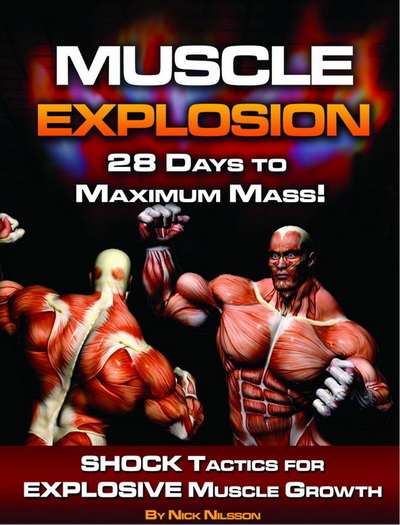The first technique is the overall concept...Positions of Flexion training, pioneered by Steve Holman of Ironman Magazine. The second is a technique that we'll apply within that POF framework to maximize the effects of it.
The combination of these two concepts is incredibly powerful and will light up your chest like almost nothing you've ever felt before.
First, this is what Positions of Flexion training is (POF for short)...
The basic idea behind POF is that it's based on 3 primary positions...mid-range, stretched and contracted. I'll go through these within the context of pec training, which is what we'll be focusing on with this technique.
The mid-range position is essentially the "middle" of the anatomical range of motion of a muscle (this is the range that your body is anatomically capable of moving in - your elbow won't bend past about 180 degrees, so that would be the anatomical range of motion of the bicep at the bottom). For chest, the mid-range exercise is any form of press...be it barbell, dumbell, machine or dip-style movement.
The strech position is the limb position where you can apply the greatest possible stretch to a muscle. For chest, that's the dumbell flye, with the greatest tension being applied with the arms behind the body (the bottom).
Also, when doing the stretch position movement, you want to make use of what's called the "myotatic reflex", also known as the "stretch reflex." This is accomplished by a quick "twitch" at the bottom of the stretch movement to set of an emergency fiber activation response in the muscle. The stretch position is a vulnerable position...so when rapidly overloaded in that position, the body responds by immediately activating more muscle fibers to protect itself from tearing.
We're using this to our advantage by twitching out the of the bottom of the stretch position on each rep. Just to be clear, this is NOT a bounce out of the bottom. You lower under control into the stretch then very deliberately "twitch" your muscles and reverse the direction. And you MUST use a moderate weight (not heavy) to be able to accomplish this.
Finally, the contracted position is the limb position where you can apply the greatest tension at the fully contracted position of the muscle. For chest, that would be a cable cross-over or pec deck style of movement where the peak tension is applied when the arms directly in front of you.
When you perform POF Training, the classic way to do it is 2 sets of the mid-range movement (which is generally a heavy, compound movement), resting 60 to 90 seconds between those sets, then 1 set of the stretch movement, rest 60 seconds, then 1 set of the contracted position movement. And you're done (in more ways than one!).
The second part of this combination is the One and a Quarter Rep technique.
We're going to be focusing the quarter rep on the "money" portion of each position that the POF training is targeted to.
This style of training is simple...you lower the weight, then you come back up 1/4 of the way, then you lower it back down, then you come all the way back up. You're doing a full rep, then a quarter rep, then a full rep, then a quarter rep, etc.
The beauty of this technique is that you spend more time (and tension) in that good part of the exercise. Even outside of POF-style training, this is a great technique to use.
When used in conjunction with POF training, it's incredibly powerful!
How To Do Positions of Flexion 1 and 1/4 Rep Training for Chest...
We're going to start with the flat barbell bench press. Set a very moderate weight on the bar...something in the realm of 60 to 75% of your 1 RM. I've just got 185 lbs on the bar.
The goal is here is not to overload the resistance but to maximize tension on the pecs.

Lower the bar to your chest under complete control.

Now come back up to just below the sticking point and hold briefly (just a second, to eliminate any tendency towards bouncing out of the bottom of the movement).

Lower back to your chest.

Then press back up to lockout.

Now repeat this sequence for 6 to 8 reps (each 1 and 1/4 counts as one rep). Once you've finished, rest 60 to 90 seconds then repeat this mid-range set. Rest 60 seconds then go to dumbell flyes.
Again, use a moderate weight for this movement - we're not trying to pile on the weight. We're trying to maximize tension, and in this case, activate the stretch reflex at the bottom.

When doing flyes, I like to angle the dumbells about 45 degrees. This feels most natural on the shoulders for me.
At the bottom position, sink down in the stretch then "twitch" the pecs and reverse direction.

Come back up 1/4 of the way (or to just below the sticking point).

Lower back down into the stretch.

Then twitch out of the bottom and come all the way back up.

Repeat this sequence for 6 to 8 reps (again, each 1 and 1/4 counts as one). Rest 60 seconds then go to cable cross-overs (we're only doing one set of the flyes and one set of the cross-overs - make them count!).
When doing cable cross-overs, I don't recommend letting the arms bend back and go straight. I find this very hard on the shoulders with no real benefit in terms of pec work. Keep the arms bent 90 degress at the top.

Bring the cable handles down in front of you until your hands are together and squeeze the pecs HARD.

Let your hands come back up 1/4 of the way.

Now come back down into the fully contracted position.

Then back up into the top position again.

Now, you can also cross your hands over in front of you rather than just stopping at hands together. This can give you a bit more contraction on the pecs.
Repeat this for 6 to 8 reps (1 and 1/4 counts as 1). What I also like to do on the last rep is a static hold...squeezing until I can't hold that position any longer.
Then you're done!
This three-part technique works the pecs in all Positions of Flexion, with focused loading on the best part of each exercise.
You get the heavier loading while doing the mid-range bench press, you get the stretch reflex activation in the flye, and you get peak contraction in the cross-over...and because you're doing it 1 and 1/4 rep style, you spend more time in the best part of each exercise.
Put it all together and you've got yourself a DEADLY chest workout that will build great pecs on even the most stubborn physique.
This method can also be used very effectively for building bigger biceps.
---
Gain 5.7 lbs of mass in the next 4 weeks? Sounds impossible, right? Not with the Muscle Explosion program. Using a powerful, strategic approach to nutrition and training, you'll see gains in mass and strength the likes of which you've never experienced before.
Share This Page...
Want More Mass-Building Techniques and Programs?
You'll find them here...
- Time-Volume Training - Build Muscle and Strength Like Clockwork
- Muscle Explosion - 28 Days to Maximum Mass
- Metamorphosis - Rebuild Your Body From The Inside Out



